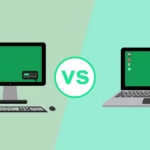Hey design lovers! Welcome back to the blog, where we look at the tools and trends that shape the creative world. Today, we’re going to talk about a topic that has been the subject of many water cooler conversations and online forums for decades: Graphic Design: Mac vs. PC As a long-time blogger who has seen a lot of changes in software and hardware, I’m here to share my thoughts and give you useful tips to help you work more efficiently every day.
It’s not just a matter of personal preference when it comes to choosing between a Mac and a PC; it’s a big decision that can affect your productivity, the software you can use, and even how professional you seem in the Graphic Design industry. Let’s break down the details and help you make a smart choice.
The Historical Context: A Legacy of Design
In the past, Mac has been closely linked to Graphic Design. This didn’t just happen. Apple’s early focus on making interfaces easy to use, combining hardware and software, and being a pioneer in desktop publishing in the 1980s and 1990s made it a leader in the creative industry. Adobe Photoshop and Illustrator, two important tools for graphic design, were first made for the Mac platform, which made this dominance even stronger.
Remember the famous “Think Different” campaign? It wasn’t just advertising; it showed that the company really believed in the creative spirit. There were often rows of beige Mac towers in design studios, which showed that the platform was the industry standard.
PC Powerhouse: Catching Up and Going Beyond?
But the landscape has changed a lot. PC makers have made big improvements to both the hardware and the software. High-performance parts, strong graphics cards, and prices that are competitive have made PCs a more appealing choice for Graphic Design. The Windows operating system from Microsoft has also grown up, making it more stable and easier to use.
Also, there are so many different types of PC hardware that designers can customize their workstations in ways that Macs, which have a more controlled ecosystem, can’t always do. The PC world has a lot of options, whether you need a powerful machine for 3D rendering or a cheaper one for web design.
Important Things for Graphic Designers to Think About
So, how do you make this choice? Let’s look at the most important things that every Graphic Designer should think about:
Software That Works Together
This is still an important point. Most major graphic design programs, like the Adobe Creative Suite (Photoshop, Illustrator, InDesign), Figma, and Sketch (which is now available on Windows), work on more than one platform. However, there may be small differences between them.
Mac: In the past, new versions of creative software often came out first on Mac. Even though this gap has gotten smaller, some designers still think of Mac as the “native” environment for some apps.
PC: PCs work with more software than Macs, including tools that are only available on PCs. They also tend to work better with older software, which can be important for some tasks.
Tip: Before you make a choice, write down the software you use every day and check to see if it works well on both Mac and PC. Look for any problems that are specific to a platform on developer forums and user reviews.
Performance and Customization of Hardware
This is where the PC usually shines in terms of price-to-performance ratio and flexibility.
Mac: Macs are known for having hardware and software that work well together, which often leads to better performance and stability. But upgrades can be costly and hard to find.
PC: PCs come with a wider range of hardware choices at different price points. You can build a computer that fits your needs exactly, and you can upgrade parts like the graphics card, RAM, and storage over time, which could make your investment last longer.
Helpful Hint: Think about the kinds of projects you usually do. A PC with a powerful processor and separate graphics card might be a better deal for you if you work with big, complicated files or do a lot of 3D rendering.
The Operating System and How It Works
A lot of the time, it comes down to what you like and what you know.
macOS: It’s known for being easy to use, having a user-friendly interface, and putting a lot of emphasis on design. A lot of designers like how clean it looks and feels, as well as features like Spotlight search and Quick Look.
Windows: Has more ways to customize and works with more hardware. Windows 11 has a modern interface and features like Snap Layouts that can help you do more than one thing at once when you’re working on graphic design.
Tip: If you can, try both macOS and Windows before making a choice. Think about which operating system makes more sense to you and fits better with how you work.
Price and Worth
This is very important for a lot of graphic designers, especially those who are just starting out or working for themselves.
Mac: Macs usually cost more up front than PCs with the same specs. But people often think they will last longer and have a higher resale value.
PC: PCs come in a wider range of prices, so you can build a powerful workstation without spending a lot of money. Being able to upgrade parts can also make them a better long-term investment in terms of money.
Tip: Make a budget for your workstation and look into the best Mac and PC setups that fit within that budget. Think about the total cost of ownership, which includes possible upgrades and software licenses.
Ecosystem and Integration
For designers who use other Apple products like the iPhone or iPad, the fact that everything works together so well in the Apple ecosystem can be a big plus. Handoff and AirDrop are two features that can help you work more efficiently.
Tip: If you use a lot of other Apple devices, think about how the integration with a Mac could help you get things done faster.
Dependability and Upkeep
Both Macs and PCs from well-known brands can be dependable.
Mac: Because Apple controls both the hardware and software, the experience is usually more stable and predictable.
PC: The reliability of PCs can change depending on the manufacturer. But it’s important to pick well-known brands and high-quality parts.
Tip: Look up the reliability ratings and customer reviews for the specific Mac and PC models you are thinking about. To make sure your workstation lasts as long as possible, buy a good surge protector and follow the best software maintenance tips.
Useful Advice for Graphic Designers: Closing the Gap
Whether you choose a Mac or a PC, these tips will help you improve your graphic design workflow:
Get a Good Monitor: For graphic design, you need a monitor with a high resolution and accurate color reproduction. Think about getting a monitor with at least 1440p resolution and good coverage of the Adobe RGB or DCI-P3 color space.
Backlink: For suggestions, read reviews on well-known tech sites like TechRadar Monitor Reviews.
Make ergonomics a priority: Designing for long periods of time can be hard on your body. To keep your posture healthy and comfortable, buy an ergonomic chair, an adjustable desk, and maybe even a separate keyboard and mouse.
Learn Keyboard Shortcuts: Knowing and using keyboard shortcuts in your graphic design software can make your work go much faster. Make cheat sheets for the apps you use the most.
Be very careful when you organize your files: To keep your projects organized and easy to find, make sure you always name your files and folders the same way. Dropbox and Google Drive are two examples of cloud storage services that can be very useful for backups and working together.
Make sure to back up your work often: Losing data can be very bad. Use both local external hard drives and cloud-based backup services to set up a regular backup plan.
Keep Your Software and Hardware Up to Date: Technology is always changing. To get the most out of your operating system and graphic design software, keep them up to date with new features, better performance, and security patches. Look into new hardware trends to make sure your workstation stays useful.
Learn how to fix things: If you know how to fix basic problems, you can save time and stress. Learn about common problems with software and hardware, and how to find solutions online.
Network with Other Designers: Get in touch with other Graphic Designers both online and in person. Get ideas from other people’s work, ask for advice, and share tips. Behance and Dribbble are two great platforms.
Interlink: If you want to know more about building a strong graphic design portfolio, read my last post.
Keep Learning and Adapting: The Graphic Design field is always changing. Stay interested, try out new tools and techniques, and keep up with changes in the industry. Courses and tutorials on sites like Skillshare and Udemy can be very helpful.
Make the most of your workspace: You can focus and get more done if your workspace is clean and organized. Make a separate area for design work and cut down on distractions.
There is no one “best” answer
In the end, there is no clear “best” choice between a Mac and a PC for Graphic Design. Your needs, budget, workflow, and personal preferences will determine which platform is best for you.
Choose a Mac if: You want a simple user experience, easy integration with other Apple products, and are okay with spending more money up front.
Choose a PC if: you want to be able to customize it, you need the best performance for your money, you need certain software to work with it, or you like the idea of being able to upgrade individual parts.
Choosing the Right Thing for You
The most important thing is to do your research, think about what you need, and maybe even try out both platforms if you can. Don’t get caught up in brand loyalty; instead, focus on the tools that will help you do your best work.
Tip: Go to a nearby electronics store and spend some time using both Mac and PC workstations that have graphic design software on them. Get to know the hardware and software.
What Will Happen to Graphic Design Platforms in the Future
The lines between Mac and PC may become even less clear as technology keeps getting better. Cloud-based design tools and cross-platform apps are becoming more popular, which could mean that people don’t have to rely on certain operating systems as much. But the main points of performance, ease of use, and cost will probably still be important in the Mac vs. PC debate for Graphic Designers.
Your Experiences Are Important!
I’d love to hear from you now! Are you a fan of Mac or a fan of PC? What made you choose that? In the comments below, tell us about your experiences and give us some tips!
Link: Check out what other designers are saying in our forum thread: Graphic Design Platform Discussion.
Thanks for being here with me today. Keep making new things and I’ll see you in the next post!




